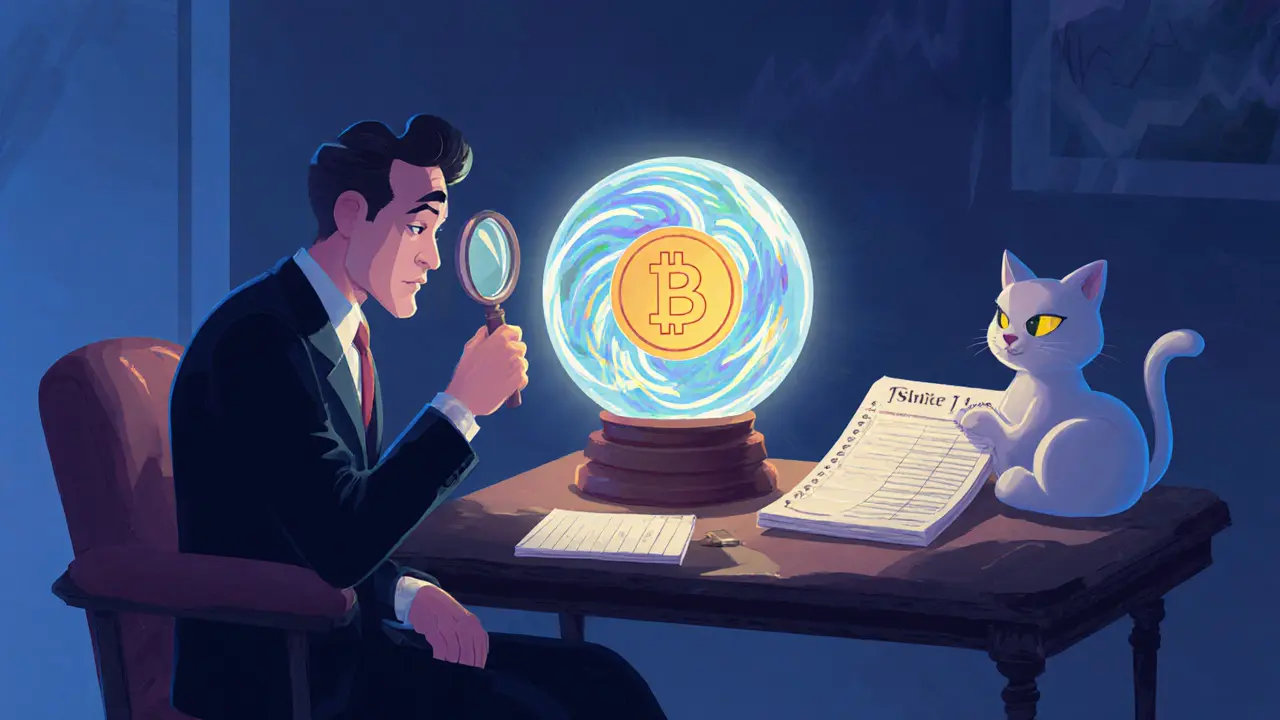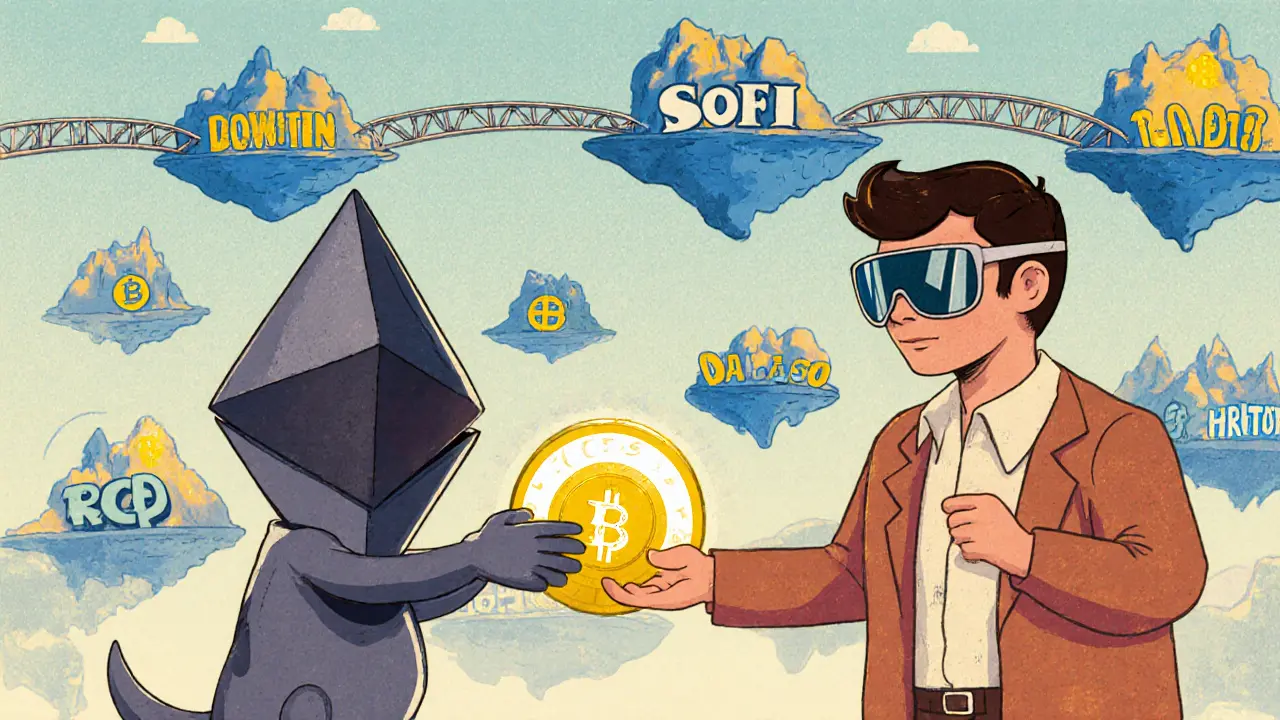RAI Finance (SOFI) Token Calculator
Token Information
Total Supply: 1,000,000,000 SOFI
Circulating Supply: 598,000,000 SOFI
Market Cap: $6.35 million
Current Price: $0.0105 USD
FDV: $10.6 million
Token Distribution
Price Analysis
Investment Analysis
Investment Value: $100.00
Expected Tokens Purchased: 0.00 SOFI
Projected Value: $0.00
Potential Profit/Loss: $0.00
Market Overview
| Exchange | Price (USD) | 24-hr Change |
|---|---|---|
| Coinbase | $0.0105 | +1.0% |
| Binance | $0.0037 | -1.96% |
| CoinGecko | $0.00411 | -37.70% |
Quick Summary
- RAI Finance is a multi‑service DeFi protocol on Ethereum that uses the SOFI token.
- SOFI’s total supply is 1billion, with about 60% already circulating.
- Prices differ by exchange - roughly $0.0105 on Coinbase, $0.0037 on Binance, $0.0041 on CoinGecko.
- Core features include cross‑chain swaps, NFT trading (ERC‑721/1155), and community‑driven social tools.
- Market cap sits under $10million, making it a mid‑cap altcoin with high volatility.
RAI Finance is a decentralized trading protocol built on the Ethereum blockchain. It bundles multi‑chain swaps, NFT marketplaces, and social features into a single interface, aiming to simplify fragmented DeFi services. The platform’s native token, SOFI, powers everything from governance to fee discounts.
What is RAI Finance?
At its core, RAI Finance tries to be a one‑stop shop for decentralized finance. Think of it as a hybrid between Uniswap, OpenSea, and a community forum, all glued together by smart contracts. Users can swap assets across multiple blockchains, list and buy NFTs, and earn rewards by participating in governance votes. The protocol’s ambition is to reduce the “app hopping” habit that many crypto users complain about.
Key Features and How They Work
- Multi‑chain swaps: Leveraging bridge technology, RAI Finance lets you move tokens between Ethereum, Binance Smart Chain, and a few Layer‑2 solutions without leaving the UI.
- NFT marketplace: Supports both ERC‑721 and ERC‑1155 standards, so creators can mint artwork, gaming items, or fractionalized assets.
- Social layer: Users can follow traders, share strategies, and earn reputation points that translate into voting power.
- Governance: SOFI holders submit proposals (e.g., SOFIP‑038) and vote on protocol upgrades.

Tokenomics & Supply Details
The SOFI token has a hard cap of 1billion units. As of October2025, roughly 598million tokens are in circulation, representing about 60% of the max supply. The token distribution is roughly:
| Category | Percentage |
|---|---|
| Liquidity Mining | 35% |
| Team & Advisors | 15% |
| Community Rewards | 20% |
| Reserve | 30% |
Market capitalization varies because the token trades on only a few exchanges. Coinbase lists a market cap of $6.35million, while Binance’s figure is $2.21million. The fully diluted valuation (FDV) - total supply multiplied by the current price - hovers around $10.6million.
Price Snapshot & Market Data
Price information is inconsistent across platforms, which is a red flag for new investors. Here’s a quick cross‑exchange look:
| Exchange | Price (USD) | 24‑hr Change |
|---|---|---|
| Coinbase | $0.0105 | +1.0% |
| Binance | $0.0037 | -1.96% |
| CoinGecko | $0.00411 | -37.70% (7‑day) |
The token peaked at $0.0461 on 16Feb2025, a 77% drop to today’s levels. Technical indicators show a bearish trend: the 14‑day RSI sits at 33, suggesting oversold conditions, while price remains below both the 50‑day ($0.00971) and 200‑day ($0.00959) simple moving averages.
How to Acquire SOFI
Because major exchanges like Binance officially do not list SOFI, your safest bet is to use decentralized exchanges (DEXes) on Ethereum. Here’s a step‑by‑step:
- Set up a wallet (MetaMask, Trust Wallet, etc.) and fund it with ETH.
- Visit a DEX aggregator such as RAI Finance’s own swap UI or use 1inch.
- Select SOFI as the target token. Copy the contract address
0xB49f...2301c0to avoid scams. - Confirm the transaction, pay the gas fee, and wait for the token to appear in your wallet.
If you prefer a centralized platform, you can buy USDC on Coinbase, then bridge it to Ethereum and swap for SOFI on the DEX. Remember, each bridge step adds gas costs.
Risks, Challenges, and Outlook
RAI Finance faces a mix of upside potential and headwinds:
- Limited exchange exposure: Fewer listings mean less liquidity and wider price swings.
- Competitive landscape: Specialized DEXes (Uniswap, SushiSwap) and dedicated NFT marketplaces often outperform RAI’s jack‑of‑all‑trades approach.
- Development transparency: The team’s roadmap is vague, and GitHub activity is hard to gauge.
- Market sentiment: The Fear & Greed Index sits at 54 (neutral), but technical signals are bearish. The token could rebound if a bull market lifts mid‑cap DeFi projects.
Analysts at CoinCodex project a modest 2.78% rise over the next month, while longer‑term forecasts (2027) hint at a possible climb to $0.0051. Those numbers are far from guarantees; they simply reflect current model assumptions.

Frequently Asked Questions
What does SOFI stand for?
SOFI is the ticker symbol for the native utility token of the RAI Finance protocol. It doesn’t represent an acronym; it’s simply the chosen market symbol.
Is SOFI an ERC‑20 token?
Yes. SOFI follows the ERC‑20 standard, which means it can be stored in any Ethereum‑compatible wallet and traded on DEXes that support ERC‑20 assets.
Can I trade SOFI on Binance?
Binance lists a SOFI‑related market pair, but officially the token is “not listed for trading and services.” Most users acquire SOFI through Ethereum DEXes and then optionally bridge it to Binance Smart Chain for trading.
How does RAI Finance’s NFT marketplace differ from OpenSea?
RAI Finance integrates NFT trading directly into its DeFi dashboard, allowing users to stake NFTs for liquidity or earn yield. OpenSea focuses purely on buying, selling, and auctioning NFTs without built‑in DeFi utilities.
What are the main risks of holding SOFI?
Key risks include low liquidity, price volatility, limited exchange listings, and uncertainty around future development milestones. As with any mid‑cap altcoin, it’s wise to only allocate money you can afford to lose.
In short, RAI Finance aims to bundle the chaotic world of DeFi into a single platform, using the SOFI token as its glue. Whether the vision translates into lasting value will depend on user adoption, exchange support, and how the team executes its roadmap.


Eugene Myazin
March 12, 2025 AT 04:43Looking at the SOFI token distribution, the liquidity mining share of 35% really shows the project's commitment to building a solid market floor. The team’s 15% slice also signals that the founders have skin in the game, which is encouraging for long‑term holders. Overall, it feels like a decent entry point for anyone wanting to dip their toes into a new DeFi token.
karyn brown
March 13, 2025 AT 00:10Honestly, the price on Binance looks like a nightmare 😂-$0.0037? That's practically dust. The way the market cap sits at $6.35 million makes me wonder if anyone actually believes this coin has real utility. 💥
Nilesh Parghi
March 13, 2025 AT 19:36Contemplating the nature of tokenomics, one might ask whether a 30% reserve truly safeguards future development or merely obscures inflationary risk. The balance between community rewards and liquidity mining mirrors the age‑old tension between altruism and self‑interest.
karsten wall
March 14, 2025 AT 15:03From a protocol perspective, the 20% community rewards allocation serves as a classic incentive layer, aligning validator participation with token velocity. Liquidity mining at 35% ensures depth across order books, mitigating slippage during high‑frequency arbitrage. The reserve pool, meanwhile, is a strategic hedge against market turbulence, akin to a treasury buffer.
Lana Idalia
March 15, 2025 AT 10:30Everyone seems to miss the obvious: with a circulating supply of nearly 600 million and a price hovering around a cent, the market cap is trivial. If you actually did the math, you'd see the projected upside is limited unless the project dramatically expands its utility suite. So stop treating this like a miracle.
Henry Mitchell IV
March 16, 2025 AT 05:56Whoa, you're right about the Binance price – it's practically a meme 😂. Still, some day traders love the volatility, so maybe there's a niche there. 🙂
Kamva Ndamase
March 17, 2025 AT 01:23Listen, the jargon you tossed around doesn't change the fact that 35% liquidity mining is a massive free‑for‑all. If the community can't polish that token, the whole thing collapses. Get real.
bhavin thakkar
March 17, 2025 AT 20:50Ah, the melodrama of market caps! Yet even a modest $6 million valuation can ignite a phoenix if the devs unleash a groundbreaking cross‑chain bridge. Drama aside, keep your eyes on the roadmap.
WILMAR MURIEL
March 18, 2025 AT 16:16When you examine the tokenomics of SOFI, the first thing that stands out is the relatively modest market cap of just over $6 million.
Such a low valuation can be a double‑edged sword, offering both the allure of high upside and the risk of limited liquidity.
Liquidity depth, in particular, is crucial because a thin order book can amplify price swings when even modest trades occur.
The distribution allocates 35% to liquidity mining, which on paper should provide a cushion, yet the actual amount of locked liquidity remains vague.
Investors should probe the vesting schedules attached to the 15% team and advisor share, as premature sell‑offs could flood the market.
Community rewards at 20% are designed to incentivize participation, but without clear mechanisms, they risk becoming a hollow promise.
The 30% reserve is a sizable buffer, though its purpose-whether for future development, buy‑backs, or a safety net-is not explicitly stated.
From a strategic standpoint, aligning the reserve with concrete milestones could boost confidence among long‑term holders.
The price discrepancy across exchanges, such as Coinbase's $0.0105 versus Binance's $0.0037, highlights potential arbitrage opportunities, but also signals fragmented liquidity.
Arbitrageurs can profit from these gaps, yet their activity may also introduce volatility that unsettles retail investors.
Looking ahead, the roadmap's emphasis on cross‑chain compatibility could be a game‑changer if executed with rigor.
Cross‑chain bridges tend to attract diverse user bases, expanding the token's utility beyond a single ecosystem.
However, security audits and transparent governance are non‑negotiable for such integrations to avoid the pitfalls witnessed in other projects.
In sum, SOFI presents a blend of promising features and notable ambiguities that warrant careful due diligence.
For those willing to navigate the uncertainties, the potential reward may justify a measured allocation within a diversified portfolio.
carol williams
March 19, 2025 AT 11:43I've got to point out that focusing on the team’s 15% slice is a bit naive; what matters more is the vesting schedule, which the article glosses over entirely.
jit salcedo
March 20, 2025 AT 07:10There's a pattern here that mirrors many so‑called ‘new’ tokens: a shiny front‑end, a massive reserve hidden away, and a price that can be pumped by a handful of insiders. If you connect the dots, the whole thing smells like a coordinated effort to dump onto unsuspecting retail.
Ally Woods
March 21, 2025 AT 02:36Looks like a typical meme‑coin hype cycle.
Kristen Rws
March 21, 2025 AT 22:03Im so excited bout SOFI, its potential could be bigg! Even whith a low price, it could skyrocket if the dev team pullss thru.
Fionnbharr Davies
March 22, 2025 AT 17:30Considering the current market conditions, it's prudent to evaluate the token's liquidity depth before allocating capital. A thin order book can exacerbate price swings, especially when large holders decide to move. Keep an eye on volume trends across the listed exchanges.
Narender Kumar
March 23, 2025 AT 12:56Esteemed investors, the present valuation of SOFI invites a contemplative deliberation of risk versus reward, wherein the modest market capitalization may yet herald a latent ascendancy should the project's roadmap be executed with unwavering fidelity.
Anurag Sinha
March 24, 2025 AT 08:23Yo, u think it's a coincidence? The same wallets that popped up on other pump‑and‑dump schemes are showing up in the reserve pool. Wake up!
Lisa Strauss
March 25, 2025 AT 03:50Let's rally around this! If we spread the word and encourage community participation, the rewards pool could become a powerful driver for organic growth.
Darrin Budzak
March 25, 2025 AT 23:16From a neutral standpoint, the token's price discrepancy across exchanges suggests arbitrage opportunities, but also highlights liquidity fragmentation that could deter larger investors.
Andrew McDonald
March 26, 2025 AT 18:43One must transcend the superficial amusement of emojis to grasp the underlying economic fundamentals-though I concede a 🙂 does lighten the discourse.
Enya Van der most
March 27, 2025 AT 14:10Charge forward, crew! Harness that enthusiasm and channel it into constructive development, and the SOFI ecosystem will thrive beyond mere speculation.